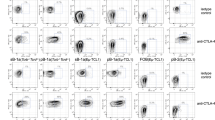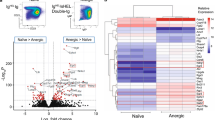Abstract
T cell homeostasis is crucial for a functional immune system, as the accumulation of T cells resulting from lack of regulatory T cells or an inability to shut down immune responses can lead to inflammation and autoimmune pathology. Here we show that Blimp-1, a transcriptional repressor that is a 'master regulator' of terminal B cell differentiation, was expressed in a subset of antigen-experienced CD4+ and CD8+ T cells. Mice reconstituted with fetal liver stem cells expressing a mutant Blimp-1 lacking the DNA-binding domain developed a lethal multiorgan inflammatory disease caused by an accumulation of effector and memory T cells. These data identify Blimp-1 as an essential regulator of T cell homeostasis and suggest that Blimp-1 regulates both B cell and T cell differentiation.
This is a preview of subscription content, access via your institution
Access options
Subscribe to this journal
Receive 12 print issues and online access
$209.00 per year
only $17.42 per issue
Buy this article
- Purchase on Springer Link
- Instant access to full article PDF
Prices may be subject to local taxes which are calculated during checkout








Similar content being viewed by others
References
Chambers, C.A., Sullivan, T.J. & Allison, J.P. Lymphoproliferation in CTLA-4-deficient mice is mediated by costimulation-dependent activation of CD4+ T cells. Immunity 7, 885–895 (1997).
Gorelik, L. & Flavell, R.A. Transforming growth factor-β in T-cell biology. Nat. Rev. Immunol. 2, 46–53 (2002).
Bouillet, P. et al. Proapoptotic Bcl-2 relative Bim required for certain apoptotic responses, leukocyte homeostasis, and to preclude autoimmunity. Science 286, 1735–1738 (1999).
Nagata, S. Fas ligand-induced apoptosis. Annu. Rev. Genet. 33, 29–55 (1999).
Lohr, J., Knoechel, B., Nagabhushanam, V. & Abbas, A.K. T-cell tolerance and autoimmunity to systemic and tissue-restricted self-antigens. Immunol. Rev. 204, 116–127 (2005).
Fontenot, J.D. & Rudensky, A.Y. A well adapted regulatory contrivance: regulatory T cell development and the forkhead family transcription factor Foxp3. Nat. Immunol. 6, 331–337 (2005).
Sakaguchi, S. Naturally arising Foxp3-expressing CD25+CD4+ regulatory T cells in immunological tolerance to self and non-self. Nat. Immunol. 6, 345–352 (2005).
D'Cruz, L.M. & Klein, L. Development and function of agonist-induced CD25+Foxp3+ regulatory T cells in the absence of interleukin 2 signaling. Nat. Immunol. 6, 1152–1159 (2005).
Fontenot, J.D., Rasmussen, J.P., Gavin, M.A. & Rudensky, A.Y. A function for interleukin 2 in Foxp3-expressing regulatory T cells. Nat. Immunol. 6, 1142–1151 (2005).
Schluns, K.S. & Lefrancois, L. Cytokine control of memory T-cell development and survival. Nat. Rev. Immunol. 3, 269–279 (2003).
Kuo, C.T., Veselits, M.L. & Leiden, J.M. LKLF: A transcriptional regulator of single-positive T cell quiescence and survival. Science 277, 1986–1990 (1997).
Lin, L., Hron, J.D. & Peng, S.L. Regulation of NF-κB, Th activation, and autoinflammation by the forkhead transcription factor Foxo3a. Immunity 21, 203–213 (2004).
Szabo, S.J. et al. A novel transcription factor, T-bet, directs Th1 lineage commitment. Cell 100, 655–669 (2000).
Zhu, J. et al. Conditional deletion of Gata3 shows its essential function in TH1-TH2 responses. Nat. Immunol. 5, 1157–1165 (2004).
Intlekofer, A.M. et al. Effector and memory CD8+ T cell fate coupled by T-bet and eomesodermin. Nat. Immunol. 6, 1236–1244 (2005).
Ichii, H. et al. Role for Bcl-6 in the generation and maintenance of memory CD8+ T cells. Nat. Immunol. 3, 558–563 (2002).
Shapiro-Shelef, M. & Calame, K. Regulation of plasma-cell development. Nat. Rev. Immunol. 5, 230–242 (2005).
Kallies, A. et al. Plasma cell ontogeny defined by quantitative changes in blimp-1 expression. J. Exp. Med. 200, 967–977 (2004).
Shapiro-Shelef, M. et al. Blimp-1 is required for the formation of immunoglobulin secreting plasma cells and pre-plasma memory B cells. Immunity 19, 607–620 (2003).
Lin, Y., Wong, K. & Calame, K. Repression of c-myc transcription by Blimp-1, an inducer of terminal B cell differentiation. Science 276, 596–599 (1997).
Chang, D.H., Angelin-Duclos, C. & Calame, K. BLIMP-1: trigger for differentiation of myeloid lineage. Nat. Immunol. 1, 169–176 (2000).
Chang, D.H. & Calame, K.L. The dynamic expression pattern of B lymphocyte induced maturation protein-1 (Blimp-1) during mouse embryonic development. Mech. Dev. 117, 305–309 (2002).
Vincent, S.D. et al. The zinc finger transcriptional repressor Blimp1/Prdm1 is dispensable for early axis formation but is required for specification of primordial germ cells in the mouse. Development 132, 1315–1325 (2005).
Ohinata, Y. et al. Blimp1 is a critical determinant of the germ cell lineage in mice. Nature 436, 207–213 (2005).
Coles, R.M., Mueller, S.N., Heath, W.R., Carbone, F.R. & Brooks, A.G. Progression of armed CTL from draining lymph node to spleen shortly after localized infection with herpes simplex virus 1. J. Immunol. 168, 834–838 (2002).
Fontenot, J.D., Gavin, M.A. & Rudensky, A.Y. Foxp3 programs the development and function of CD4+CD25+ regulatory T cells. Nat. Immunol. 4, 330–336 (2003).
Hori, S., Nomura, T. & Sakaguchi, S. Control of regulatory T cell development by the transcription factor Foxp3. Science 299, 1057–1061 (2003).
Fontenot, J.D. et al. Regulatory T cell lineage specification by the forkhead transcription factor foxp3. Immunity 22, 329–341 (2005).
Kuhn, R., Lohler, J., Rennick, D., Rajewsky, K. & Muller, W. Interleukin-10-deficient mice develop chronic enterocolitis. Cell 75, 263–274 (1993).
Annacker, O. et al. CD25+ CD4+ T cells regulate the expansion of peripheral CD4 T cells through the production of IL-10. J. Immunol. 166, 3008–3018 (2001).
Mottet, C., Uhlig, H.H. & Powrie, F. Cutting edge: cure of colitis by CD4+CD25+ regulatory T cells. J. Immunol. 170, 3939–3943 (2003).
Zeng, R. et al. Synergy of IL-21 and IL-15 in regulating CD8+ T cell expansion and function. J. Exp. Med. 201, 139–148 (2005).
Ranger, A.M., Oukka, M., Rengarajan, J. & Glimcher, L.H. Inhibitory function of two NFAT family members in lymphoid homeostasis and Th2 development. Immunity 9, 627–635 (1998).
Malek, T.R. & Bayer, A.L. Tolerance, not immunity, crucially depends on IL-2. Nat. Rev. Immunol. 4, 665–674 (2004).
Bopp, T. et al. NFATc2 and NFATc3 transcription factors play a crucial role in suppression of CD4+ T lymphocytes by CD4+ CD25+ regulatory T cells. J. Exp. Med. 201, 181–187 (2005).
Marie, J.C., Letterio, J.J., Gavin, M. & Rudensky, A.Y. TGF-β1 maintains suppressor function and Foxp3 expression in CD4+CD25+ regulatory T cells. J. Exp. Med. 201, 1061–1067 (2005).
Bachmann, M.F., Kohler, G., Ecabert, B., Mak, T.W. & Kopf, M. Cutting edge: lymphoproliferative disease in the absence of CTLA-4 is not T cell autonomous. J. Immunol. 163, 1128–1131 (1999).
Bacchetta, R., Gregori, S. & Roncarolo, M.G. CD4+ regulatory T cells: mechanisms of induction and effector function. Autoimmun. Rev. 4, 491–496 (2005).
Asseman, C., Read, S. & Powrie, F. Colitogenic Th1 cells are present in the antigen-experienced T cell pool in normal mice: control by CD4+ regulatory T cells and IL-10. J. Immunol. 171, 971–978 (2003).
King, C., Ilic, A., Koelsch, K. & Sarvetnick, N. Homeostatic expansion of T cells during immune insufficiency generates autoimmunity. Cell 117, 265–277 (2004).
Ozaki, K. et al. Regulation of B cell differentiation and plasma cell generation by IL-21, a novel inducer of Blimp-1 and Bcl-6. J. Immunol. 173, 5361–5371 (2004).
Keller, A.D. & Maniatis, T. Identification and characterization of a novel repressor of β-interferon gene expression. Genes Dev. 5, 868–879 (1991).
Taki, S. Type I interferons and autoimmunity: lessons from the clinic and from IRF-2-deficient mice. Cytokine Growth Factor Rev. 13, 379–391 (2002).
Badovinac, V.P., Porter, B.B. & Harty, J.T. Programmed contraction of CD8+ T cells after infection. Nat. Immunol. 3, 619–626 (2002).
Brady, J., Hayakawa, Y., Smyth, M.J. & Nutt, S.L. IL-21 induces the functional maturation of murine NK cells. J. Immunol. 172, 2048–2058 (2004).
Nutt, S.L. et al. Independent regulation of the two Pax5 alleles during B-cell development. Nat. Genet. 21, 390–395 (1999).
Belz, G.T., Xie, W. & Doherty, P.C. Diversity of epitope and cytokine profiles for primary and secondary influenza a virus-specific CD8+ T cell responses. J. Immunol. 166, 4627–4633 (2001).
Metcalf, D., Di Rago, L., Mifsud, S., Hartley, L. & Alexander, W.S. The development of fatal myocarditis and polymyositis in mice heterozygous for IFN-γ and lacking the SOCS-1 gene. Proc. Natl. Acad. Sci. USA 97, 9174–9179 (2000).
Read, S., Malmstrom, V. & Powrie, F. Cytotoxic T lymphocyte-associated antigen 4 plays an essential role in the function of CD25+CD4+ regulatory cells that control intestinal inflammation. J. Exp. Med. 192, 295–302 (2000).
Acknowledgements
We thank J. Carneli, K. D'Costa, L. Di Rago and J. Brady for assistance; D. Huang, G. Davey, Y. Zhan, J. Dromey, W. Heath, D. Tarlinton and A. Strasser for reagents, advice and critical reading of the manuscript; and S. Read (Bio21 Molecular Science and Biotechnology Institute, Melbourne, Victoria, Australia) for help in setting up and analyzing the colitis model. Supported by The Walter and Eliza Hall Institute (Metcalf Fellowship to S.L.N.), the Deutsche Forschungsgemeinschaft (A.K. and M.H.), the Leukaemia Foundation of Australia (A.K.), the National Institutes of Health (CA22556 to D.M.), the Wellcome Trust (G.T.B.), Howard Hughes International Fellowship (G.T.B.) and the National Health and Medical Research Council of Australia.
Author information
Authors and Affiliations
Corresponding author
Ethics declarations
Competing interests
The authors declare no competing financial interests.
Supplementary information
Supplementary Fig. 1
Blimp-1 controls the number of effector and memory CD4+ T cells. (PDF 831 kb)
Rights and permissions
About this article
Cite this article
Kallies, A., Hawkins, E., Belz, G. et al. Transcriptional repressor Blimp-1 is essential for T cell homeostasis and self-tolerance. Nat Immunol 7, 466–474 (2006). https://doi.org/10.1038/ni1321
Received:
Accepted:
Published:
Issue Date:
DOI: https://doi.org/10.1038/ni1321
This article is cited by
-
Increased Nasal Blimp1 + Treg Cells After Sublingual Immunotherapy Reflect the Efficacy of Treatment in Allergic Rhinitis
Advances in Therapy (2024)
-
Reprogramming T cell differentiation and exhaustion in CAR-T cell therapy
Journal of Hematology & Oncology (2023)
-
The role of transcription factors in shaping regulatory T cell identity
Nature Reviews Immunology (2023)
-
Immune checkpoint therapy for solid tumours: clinical dilemmas and future trends
Signal Transduction and Targeted Therapy (2023)
-
Blimp-1 is a prognostic indicator for progression of cervical intraepithelial neoplasia grade 2
Journal of Cancer Research and Clinical Oncology (2022)



